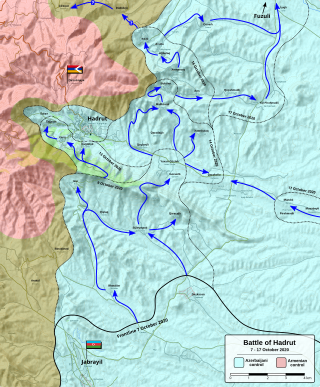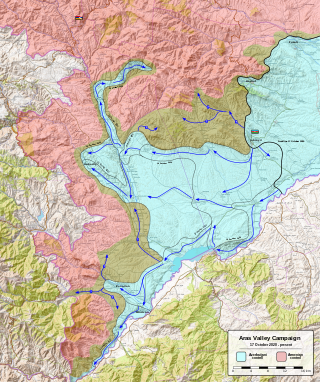
Lachin is a town in Azerbaijan and the administrative centre of the Lachin District. It is located within the strategic Lachin corridor, which linked the region of Nagorno-Karabakh with Armenia.
Qacar is a village in the Fuzuli District of Azerbaijan.
Yuxarı Veysəlli is a former village in the current Khojavend District of Azerbaijan. Before its abolition, the village was part of the Veysalli Rural administrative division of the Fuzuli District. By the Law of the Republic of Azerbaijan dated December 5, 2023, Yuxari Veysalli was abolished, and its territory was transferred to the Khojavend District.

Zabukh or Aghavno is a village in the Lachin District of Azerbaijan. The village came under the control of the breakaway Republic of Artsakh after 1992 and was renamed Aghavno and settled by Armenians. Following the 2020 Nagorno-Karabakh war, Zabukh came under the control of the Russian peacekeeping forces in Nagorno-Karabakh. On 26 August 2022, Azerbaijan regained control of Zabukh along with other settlements located along the former route of the Lachin corridor, including Lachin and Sus.

Sus is a village in Lachin District of Azerbaijan. It was formerly under the supervision of the Russian peacekeeping force following the ceasefire agreement that ended the 2020 Nagorno-Karabakh war. The village came under the de facto control of the breakaway Republic of Artsakh from 1992–2022, is administrated as part of its Kashatagh Province, and is de jure part of the Lachin District of Azerbaijan. As of 26 August 2022, Azerbaijan regained control of villages in the Lachin corridor, including Lachin, Sus, and Zabukh.

Qorçu is a village in the Lachin District of Azerbaijan. The village is 64 kilometres away from Lachin, and is 1,884 meters above sea level. It is located near a large forested area.

Gazyan is a village in the Qubadli District of Azerbaijan.

Balasoltanlı is a village in the Qubadli District of Azerbaijan.
Divanalılar is a village in the Fuzuli District of Azerbaijan. The village had an Azerbaijani majority prior to their expulsion during the First Nagorno-Karabakh War. It was under the control of Armenian forces of the self-proclaimed Republic of Artsakh since the First Nagorno-Karabakh War. However, it was announced to be recaptured by the Azerbaijani Army on November 7, 2020.
Qiyaslı is a village in the Qubadli District of Azerbaijan.

The Armenian-occupied territories surrounding Nagorno-Karabakh were areas of Azerbaijan, situated around the former Nagorno-Karabakh Autonomous Oblast (NKAO), which were occupied by the ethnic Armenian military forces of the breakaway Republic of Artsakh with military support from Armenia, from the end of the First Nagorno-Karabakh War (1988–1994) to 2020, when the territories were returned to Azerbaijani control by military force or handed over in accordance to the 2020 Nagorno-Karabakh ceasefire agreement. The surrounding regions were seized by Armenians under the justification of a "security belt" which was to be traded for recognition of autonomous status from Azerbaijan.
Yuxarı Məzrə is a former village in the current Khojavend District of Azerbaijan. Before its abolition, the village was part of the Sarijali Rural administrative division of the Jabrayil District. By the Law of the Republic of Azerbaijan dated December 5, 2023, Yukhary Mazra was abolished, and its territory transferred to Khojavend District.

The Lachin corridor was a mountain road in Azerbaijan that linked Armenia and Karabakh.

The Second Nagorno-Karabakh War was an armed conflict in 2020 that took place in the disputed region of Nagorno-Karabakh and the surrounding occupied territories. It was a major escalation of an unresolved conflict over the region, involving Azerbaijan, Armenia and the self-declared Armenian breakaway state of Artsakh. The war lasted for 44 days and resulted in Azerbaijani victory, with the defeat igniting anti-government protests in Armenia. Post-war skirmishes continued in the region, including substantial clashes in 2022.
This is an account of engagements which occurred during the Second Nagorno-Karabakh War, primarily based on announcements from the belligerents. The war has been characterized by the use of armoured warfare; drone warfare, especially the use of Turkish-made Bayraktar TB2 and Israeli loitering munition Harop drones; heavy artillery; rocket attacks; and trench warfare. It has also featured the deployment of cluster munitions, which are banned by the majority of the international community but not by Armenia or Azerbaijan: Azerbaijan states that Armenia has deployed cluster munitions against civilians, and international third parties have confirmed evidence of Azerbaijan's use of cluster munitions against civilian areas of Nagorno-Karabakh. A series of ballistic missile attacks have inflicted mass civilian casualties in Ganja, Azerbaijan, while civilian residences and infrastructure in Stepanakert, and elsewhere have been targeted, inflicting casualties and causing extensive damage.

The Battle of Hadrut began in early October 2020 in Hadrut and its surrounding villages and heights, now seat of Khojavend District, Azerbaijan, and earlier controlled by the self-proclaimed Republic of Artsakh and was part of Hadrut Province.

Aras Valley campaign was a military operation launched by Azerbaijan against the breakaway Republic of Artsakh along the Aras River in the Azerbaijan–Iran border during the Second Nagorno-Karabakh War.

The Victory Day is a public holiday in Azerbaijan that is celebrated on 8 November, in commemoration of Azerbaijani victory in the 2020 Nagorno-Karabakh war. Established by the decree of the President of Azerbaijan from 2 December 2020, the holiday is celebrated on the day of the recapture of Shusha. It is a non-working holiday.

The Memorial Day in Azerbaijan is a public holiday in Azerbaijan for honoring and mourning the military personnel who have died while serving in the Azerbaijani Armed Forces during the 2020 Nagorno-Karabakh war, officially labelled as The Patriotic War. Established by the decree of the President of Azerbaijan, dated 2 December 2020, the holiday is held on 27 September, the day when the war began.

In the aftermath of the Second Nagorno-Karabakh War, peacekeeping operations were initiated by Russia in the Nagorno-Karabakh region to monitor the ceasefire between the Armenian and Azerbaijani forces. Separate from the Russian operation, Turkey also has personnel working in a joint Russian–Turkish monitoring centre.













